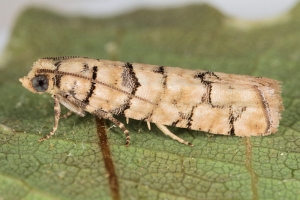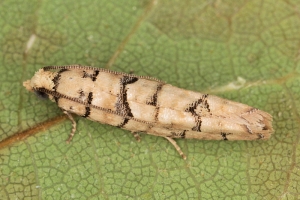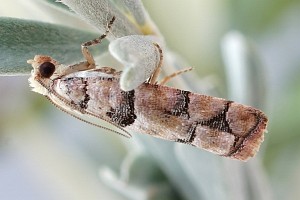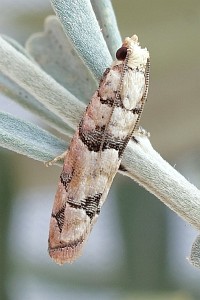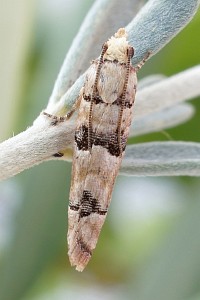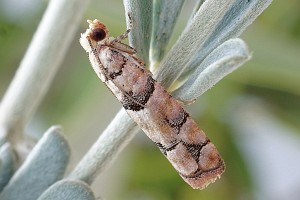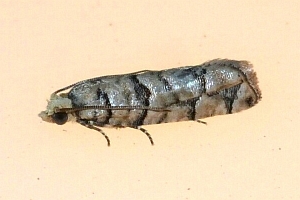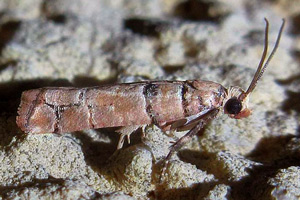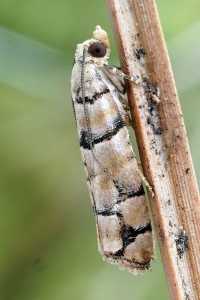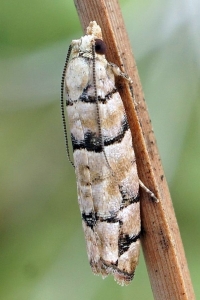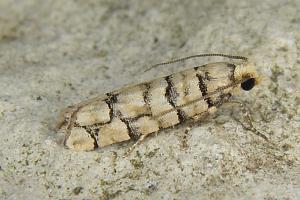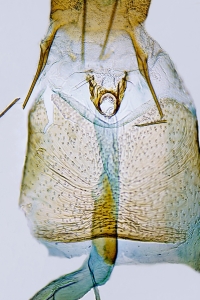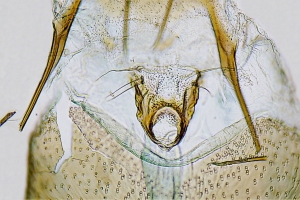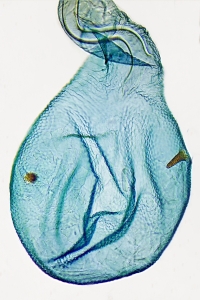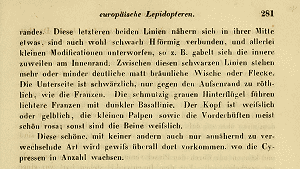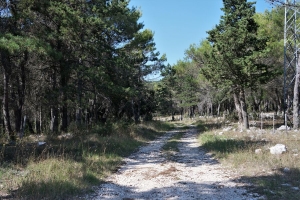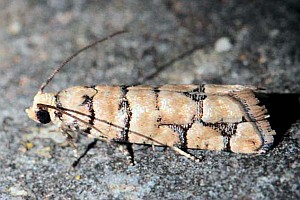
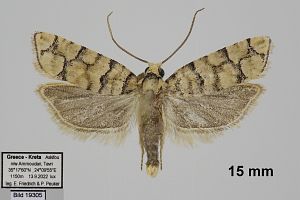
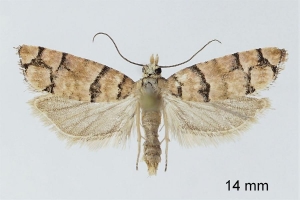
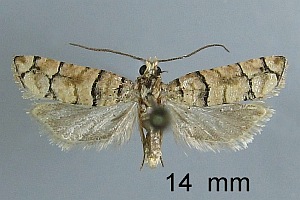
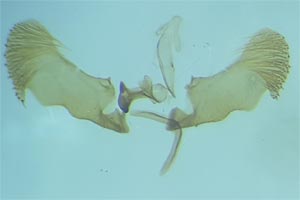
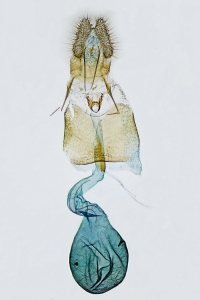
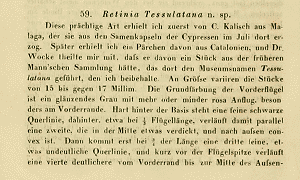
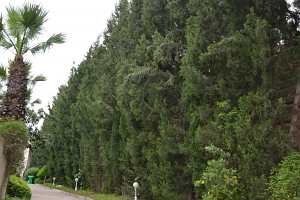
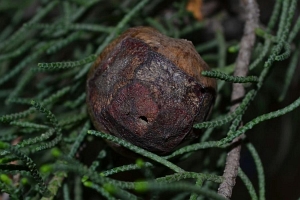
1. Lebendfotos
1.1. Falter
2. Diagnose
2.1. Männchen
2.2. Weibchen
2.3. Geschlecht nicht bestimmt
2.4. Genitalien
2.4.1. Männchen
2.4.2. Weibchen
2.5. Erstbeschreibung
3. Biologie
3.1. Habitat
3.2. Raupennahrungspflanzen
3.3. Nahrung der Raupe
- [Cupressaceae:] Cupressus sempervirens (Mittelmeer-Zypresse)
P. tessulatana entwickelt sich in heranreifenden Zypressen-Zapfen. Schon in der Erstbeschreibung von Staudinger (1871) ist zu erfahren: "Diese prächtige Art erhielt ich zuerst von C. Kalisch aus Malaga, der sie aus den Samenkapseln der Cypressen im Juli dort erzog. [...] wird gewiß überall dort vorkommen, wo die Cypressen in Anzahl wachsen."
Roquesa et al. (1999) schreiben in der Zusammenfassung ihrer Untersuchung von natürlichen und gepflanzten Zypressen-Beständen in Griechenland, Albanien und Malta: "The cone entomofauna (seven insect and one mite species) did not differ between the native and introduced ranges of cypress. A tortricid, Pseudococcyx tessulatana (Lepidoptera:Tortricidae) and a mite, Trisetacus juniperinus (Acari:Nalepellidae), were the most damaging pests because they usually killed cones during the growth period." Im Text heißt es dann: "T. juniperinus and a tortricid, Pseudococcyx tessulatana (Staudinger) (Lepidoptera:Tortricidae), appeared to be the most important pests both in terms of the attack period and the type of damage caused. Both species attacked cones during the growth period as well as fullgrown cones during the process of seed maturation (table I). Attack during the growth period generally resulted in the destruction of the whole cone but fullgrown cones usually survived the pest attack although a large portion of the seeds were destroyed." Und weiter: "Pest damage varied with stand location, year and cone development stages. In 1994, more than 40 % of the cones were killed by pests during the 2nd year of development in ten of the twenty stands surveyed in Greece (table II). Damage resulted mostly from the feeding by P. tessulatana larvae which dominated the pest complex in 13 of the stands, and destroyed up to 98 % of the cones during the growth period in Eleousa (Rhodes)." Offensichtlich kommen aber durchweg genug Zapfen bis zur Samenreife, so dass die natürliche Verjüngung der Zypressen-Bestände nicht gefährdet ist und ich nicht ganz verstehe, warum man hier von einem Schädling ("pest") spricht.
(Autor: Erwin Rennwald)
4. Weitere Informationen
4.1. Andere Kombinationen
- Retinia tessulatana Staudinger, 1871 [Originalkombination]
- Blastesthia tessulatana (Staudinger, 1871)
4.2. Faunistik
Die Art ist mit natürlichen und gepflanzten Zypressen-Beständen im Mittelmeerraum weit verbreitet. Retzlaff & Seliger (2005: 139) nennen den Fund eines Exemplars in Deutschland, Nordrhein-Westfalen und kommentieren: „[...] wahrscheinlich mit Pflanzenmaterial aus dem Süden eingeschleppt“.
Agassiz et al. (2013: 112) führen die Art bei den "adventive species" und schreiben zu England: "One Bridlington, Yorkshire, 2011: (Beaumont, 2012). European."
Bolt & Schmid (2024: 8) bestätigen das zuvor nur durch Literaturangaben belegte Vorkommen in der Schweiz (Tessin): "Fundort: TI Morcote, Sasso Bisolo, 450 m, 24.07.2021, leg. D. Bolt. 1♂ am Licht in einem trockenheissen, felsigen Eichenwald oberhalb des Lago di Lugano. [...] Am Fundort in Morcote sind reichlich Zypressen in den Kirchenanlagen und Privatgärten vorhanden."
(Autoren: Erwin Rennwald und Jürgen Rodeland)
4.3. Literatur
- Agassiz, D.J.L., Beavan, S.D. & R.J. Heckford (2013): Checklist of the Lepidoptera of the British Isles. - Royal Entomological Society. 206pp.
- Bolt, D. & J. Schmid (2024): Für die Schweiz neue Schmetterlingsnachweise und Bestätigungen von bis anhin zweifelhaften Schweizer Vorkommen (Lepidoptera). — Opuscula Lepidopterologica Alpina, 5: 1-16. [zum PDF-Download auf researchgate.net]
- Retzlaff, H. & R. Seliger (2005): Rote Liste und Artenverzeichnis der Wickler in Nordrhein-Westfalen (Lep., Tortricidae und Choreutidae). — Melanargia 17 (4): 101-147. [PDF auf ag-rh-w-lepidopterologen.de (ganzes Heft)]
- Roquesa, A., Markalasb, S., Rouxa, G., Pana, Y.-z., Suna, J.-h. & J.-P. Raimbaulta (1999): Impact of insects damaging seed cones of cypress, Cupressus sempervirens, in natural stands and plantations of southeastern Europe . — Ann. For. Sci. 56 (2): 167-177. [PDF auf afs-journal.org]
- Erstbeschreibung: Staudinger, O. (1871) ["1870"]: Beschreibung neuer Lepidopteren des europäischen Faunengebiets (Schluß). — Berliner Entomologische Zeitschrift 14: 273-330.




![Vorkommen auf der Krim [Sinev (2021)]](/res/img/flag/ua-kri.gif)
![Einzelnachweis in Großbritannien [1 Tier eingeschleppt]](/res/img/flag/gb.gif)
![Vorkommen in den Niederlanden [Huisman, Koster, Muus & van Nieukerken (2013)]](/res/img/flag/nl.gif)
![Vorkommen in Frankreich (europäisches Territorium ohne Korsika) [Vandromme et al. (2020): Liste systématique et taxinomique des Lépidoptères de France]](/res/img/flag/fr.gif)
![Vorkommen in Spanien (Festland) [Vives Moreno A. (2014)]](/res/img/flag/es.gif)
![Vorkommen auf den Kanarischen Inseln [Forum: https://www.lepiforum.de/1_forum_2019.pl?page=1;md=read;id=181119]](/res/img/flag/es-cn.png)
![Vorkommen auf den Balearischen Inseln (Spanien) [Vives Moreno A. (2014)]](/res/img/flag/es-ib.gif)
![Vorkommen in Portugal (Festland) [Corley (2015): Lepidoptera of Continental Portugal]](/res/img/flag/pt.gif)
![Vorkommen in Italien (Festland und kleine festlandsnahe Inseln) [Trematerra (1995): Checklist delle Specie della Fauna Italiana 85]](/res/img/flag/it.gif)
![Vorkommen auf Sardinien [Trematerra (1995): Checklist delle Specie della Fauna Italiana 85]](/res/img/flag/it-sar.png)
![Vorkommen in Sizilien [Trematerra (1995): Checklist delle Specie della Fauna Italiana 85]](/res/img/flag/it-sic.png)
![Vorkommen in Malta [Sammut (1984)]](/res/img/flag/mt.gif)
![Vorkommen in Griechenland (Festland und festlandsnahe Inseln) [Trematerra & Colacci (2022)]](/res/img/flag/gr.png)
![Vorkommen auf Kreta [Foto im Forum]](/res/img/flag/gr.gif)
![Fragliches Vorkommen im europäischen Teil der Türkei [Koçak & Kemal (2018): Meldung für nicht vollständig in Europa liegende Provinz 34 (İstanbul)]](/res/img/flag/tr.gif)
![Fragliches Vorkommen auf Zypern [nur Fauna Europaea (zu prüfen)]](/res/img/flag/cy.gif)
![Vorkommen in Russland (zwischen Manytsch-Niederung und Kaukasus-Hauptkamm) [Sinev (2021)]](/res/img/flag/ru.gif)
